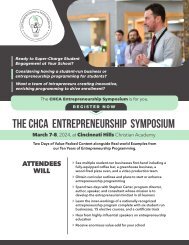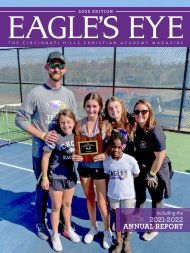Mission, Vision, Competencies, Standards, and Benchmarks
A Statement of Curriculum CINCINNATI HILLS CHRISTIAN ACADEMY Edyth B. Lindner Campus Otto Armleder Memorial Education Center Founders’ Campus Martha S. Lindner Campus 2019 Edition
A Statement of Curriculum
CINCINNATI HILLS CHRISTIAN ACADEMY
Edyth B. Lindner Campus
Otto Armleder Memorial Education Center
Founders’ Campus
Martha S. Lindner Campus
2019 Edition
Create successful ePaper yourself
Turn your PDF publications into a flip-book with our unique Google optimized e-Paper software.
‣ The amount (weight) of matter is conserved when it changes form, even in transitions<br />
in which it seems to vanish. (4-6)<br />
‣ Measurement of a variety of properties can be used to identify particular materials. (K-<br />
6)<br />
‣ When two or more different substances are mixed, a new substance with different<br />
properties may be formed; such occurrences depend on the substances <strong>and</strong> the<br />
temperature. (4-6)<br />
‣ No matter what reaction or change in properties occurs, the total weight of the<br />
substances does not change. (4-6)<br />
‣ The greater the mass of the object, the greater the force needed to achieve the same<br />
change in motion. For any given object, a larger force causes a larger change in<br />
motion. (K-6)<br />
‣ For any pair of interacting objects, the force exerted by the first object on the second<br />
object is equal in strength to the force that the second object exerts on the first, but in<br />
the opposite direction (Newton’s third law) (4-6)<br />
‣ The motion of an object is determined by the sum of the forces acting on it; if the total<br />
force on the object is not zero, its motion will change. (4-6)<br />
‣ Electric <strong>and</strong> magnetic (electromagnetic) forces can be attractive or repulsive, <strong>and</strong> their<br />
sizes depend on the magnitudes of the charges, currents, or magnetic strengths<br />
involved <strong>and</strong> on the distances between the interacting objects. (4-6)<br />
‣ Electric, magnetic, <strong>and</strong> gravitational forces between a pair of objects do not require<br />
that the objects be in contact – for example, magnets push or pull from a distance. (4-<br />
6)<br />
‣ Forces that act at a distance (electric <strong>and</strong> magnetic) can be explained by fields that<br />
extend through space <strong>and</strong> can be mapped by their effect on a test object. The sizes<br />
of the forces in each situation depend on the properties of the objects <strong>and</strong> their<br />
distances apart. (4-6)<br />
‣ The gravitational force of Earth acting on an object near Earth’s surface pulls that<br />
object toward the planet’s center. (4-6)<br />
‣ Energy is present whenever there are moving objects, sound, light, or heat. (K-6)<br />
‣ The faster a given object is moving, the more energy it possesses. (4-6)<br />
‣ Energy can be moved from place to place by moving objects or through sound, light,<br />
or electric currents. (4-6)<br />
‣ Light transfers energy from place to place. For example, energy radiated from the<br />
Sun is transferred to Earth by light. When this light is absorbed, it warms Earth’s l<strong>and</strong>,<br />
air, <strong>and</strong> water <strong>and</strong> facilitates plant growth. (4-6)<br />
‣ Energy can be transferred from place to place by electric currents, which can then be<br />
used locally to produce motion, sound, heat, or light. (4-6)<br />
‣ When objects collide, the contact forces transfer energy to change the object’s<br />
motions. (4-6)<br />
‣ Magnets can exert forces on other magnets or on magnetizable materials, thereby<br />
transferring energy even when the objects are not touching. (4-6)<br />
‣ A system of objects may also contain stored (potential) energy, depending on their<br />
relative positions. (4-6)<br />
‣ When two objects interact, each one exerts a force on the other that can cause energy<br />
to be transferred to or from the object. (4-6)<br />
Back to Table of Contents


















